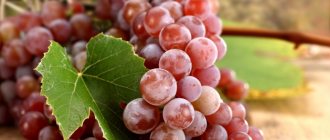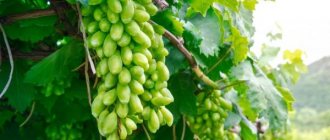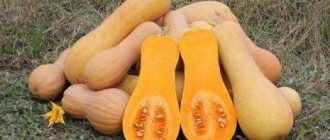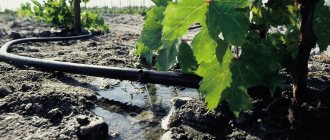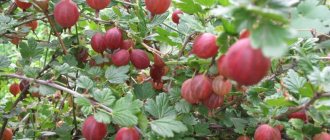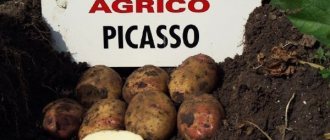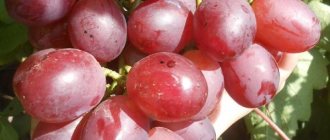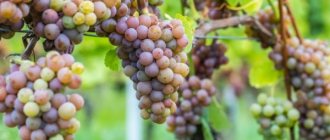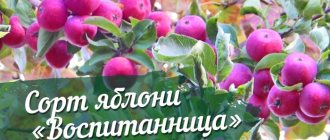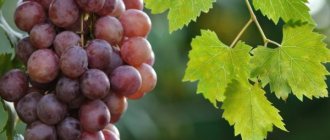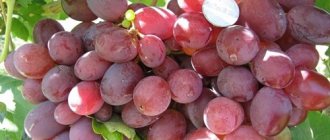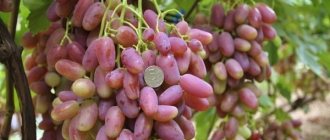Description of the variety
Gardeners value the variety for its abundant, friendly, stable harvest.
Many years of viticulture experience indicate that the unpretentious Bogatyanovsky feels good in the southern regions of our country and successfully takes root in central Russia. In the climatic conditions of its historical homeland - Novocherkassk - Bogatyanovsky ripens at the end of August, in the Central Black Earth Region - at the beginning of September. The vigorous hybrid grows both on its own roots and in grafted crops due to its excellent compatibility with rootstocks. Bogatyanovsky is characterized by rapid ripening and high survival rate of cuttings.
Typical features of Bogatyanovsky grapes:
- not afraid of drought and heat;
- the yield from one vine reaches 10–15 kg;
- frost-resistant - tolerates temperatures down to –25 °C without shelter without loss;
- with appropriate prevention, it is resistant to gray rot, mildew and oidium;
- early ripening - fully ripens in the climate of central Russia.
A powerful branched plant reaches a height of 2.5 m; the lignified fibrous shoots are light brown in color. The vines ripen more than 70% of their length. Straight, tall bushes with a fairly developed root system look decorative at any time of the year.
Lignified Bogatyanovsky grape vines ripen more than 70% of their length
Three-lobed leaves with a strong dissection, round shape and rich green color have pronounced tubercles and bristly pubescence. The petiole of the leaves is open, the leaf teeth are not sharp, triangular, of different sizes.
Small green inflorescences are bisexual, form a panicle and bloom together in mid-June. The hermaphroditic flower of selected grapes does not require the close proximity of another pollinating variety. Bogatyanovsky needs regular normalization of inflorescences, since the recommended load of buds (these formations that unite the buds and ensure their proper development appear in the leaf axils) is no more than 45. If you do not remove excess ovaries, the vine may not withstand heavy grape bunches.
The Bogatyanovsky grape variety requires regular normalization of inflorescences so as not to overload the vine with clusters
The berries of the presented table grapes are large, smooth, oval, and exceed in weight those of the “parent” varieties. The color is bright light green, turning into golden yellow when ripe with a brownish, sometimes pinkish tint (a hereditary feature of the Kishmish variety), located on symmetrical clusters with medium density. The fruits with thin, delicate skin and juicy, fleshy pulp are distinguished by a nutmeg aroma, have a subtle honey-like flavor, weigh from 10 to 14 g, sometimes weighing up to 25 g. From 1 to 3 seeds is the norm for Bogatyanovsky. Average berry size:
- length - about 3.5 cm,
- width - 2.7–3 cm.
The harmonious combination of sugar content (19–22%) and acidity (approximately 8%) gives the grapes a soft, sour taste, emphasizing the peculiarity of the variety (the fruits are not as sugary as Kishmish).
The complete absence of peas (shrinking of fruits) and the evenness of ripening fruits set Bogatyanovsky apart from other varieties
| Sign | Character traits | Points |
| Appearance of bunches and berries |
| 10 |
| Taste and aroma |
| 8 |
| Skin properties and pulp consistency |
| 9 |
Large, conical bunches of Bogatyanovsky, with proper care, timely feeding and regular watering, weigh from 400 g to 1 kg, some specimens reach 1.5 kg. On the vine of the amateur variety, almost every single berry ripens at the same time; slightly loose clusters are less susceptible to pea-bearing. The fruits rarely crack and are firmly attached to the petioles, and tolerate transportation and storage well.
Forum statistics
207035 Messages in 1634 Topics from 5593 Users. Latest user: Amaya Latest post: “Figs. Varieties and grown..." ( Today at 07:43:43) Latest messages on the forum.
Now on the forum
37 Guests, 9 Users
Users in the last 15 minutes: lomakin1969, therapist, Capricorn, Alexander Vl., Elvira2017, Marshal, Andrey76, Slavka, Mikhail77 [Blocked] [Section Moderator] [Forum Moderator]
Maximum online today: 77 . All-time maximum online: 2758 (28 July 2021, 17:22:51)
Users who visited the forum in the last 24 hours
Total: 296
(Visible: 295, Hidden: 1) 1963, lomakin1969, Capricorn, therapist, Alexander Vl., Elvira2017, Marshal, Andrey76, Slavka, Mikhail77, ElenkaF, Tatyana B, Alex65, Cherkessk, Eugene, zsb, leonidych, vladimirM, yotmast, mers, Serg1707, SNovichek, hanter64, znakomij, Alexander K, Vardan, Sergey Fer, Anatoly Sivkov, Alexey V, Ilya 77, Andrey Gladilin, Tatyana A., Belgorodets, in Astrakhan, Oksana Kopp, sem_en, Vladimir 153, skier, Igor Viktorovich, slavalimon, Primorets, OlgaOs, SANYCH, 31rus, mystic69, DorontsovPeter, Andrey Tsvetkov, Buba, igor222, Elena Z, vlad51, Kenig, Nikolay Rex, Sergey 1965, Vladimir Buturlakin, DSW, psv1960, Dmitry 77, Vasily V., Vyacheslav03, Natalia Nikolaevna, Sergey Tashchiyan, Nikolay S., Igor Sergeevich, alexsandr, kvg, Pioneer, Ekaterina Polyanina, nicson7, Elena Aleshchenko, Alexander-ask-34, Verona, Igor F., Taker, Tikhiy, Henry, Yuri72, L .A.P., Yuri Gaivoronsky, Sergeevich, Sergey Chistokletov, Svetlana Streletskaya, Galinka, Alexey Deminov, Igor Naumov, Vyacheslav136, Gloomy, Katrin, AndSanych, Alexander Mikhno, Ded31, Oleg Filippov, Vladimir ++, Svetla777, Mikhail Alekseevich, Lydia58, ALEXANDER BRYANSKY, Vladimir-kanevskaya, DIL, Amber7394, Marina Protasova, TITOVA LYUBOV, Linx, alexander66, Natalya M, Mikhail Fesenko, Amaya, Alexander71, Boris 1952, tsv, Maximilian, 25nata35, nadia, GALINA ANOKHINA, Igor_ K, Alexander Kolesnikov, Ivan Levin, Pitko, weather forecaster, eSAa, cecet71, atseton, Alexander Smirnov, Vladimir Kostochkin, Vladimir Berdnikov, Gocha, pioneer-2, LeXa_KoT, Sergey 61, Sergey Yuryev, Erem, alexss, Evgeniy52, Skif, Vladimir Kovba, dayton , Yuri Semenov, N.A. Sokolov, Pavlentiy, Sa-shura, Volgogradka, Dmitry Anatolyevich, Grandfather Igor, Andrey Lis, Bublichenko Alexander M, Marina Krymskaya, stenlly2010, irahelm, Vyacheslav Vladimirovich, Vladimir Shilov, Aprel, Dmitry Badaev, gheo55 , Yura, y_fed, rambo, Yagodka, Valentina Ivanovna, Kryn, oleg9f, DED2, Svetlana Korotina, Oleg Ivanovich delivered, Eduard., santra, L2k2m7n, Alexander48, Viknik, Andrey 31, m2d, Valery Rastorguev, soshnin yura, Gardener - amateur , Galina, Vasily1111, gardener, marlin64, Salex, sergei, Sergey Ko, Ramiz, Victor_, kosmos, potap05, Yuri 36, VitalySD, Inna161, Vova Kapran, Vladimir Shcherbinin, Valerie, niy1, cfibr, Andrey68, kulol3, thanatos, Serzh1978 , Realist, Artur53, max2008-01, LOZA, AlexanderD, Grandfather Young, Natasha, Zayac, ketch, Rita, alx-74, Iv Iv, Alexander150, Igor K, Vasily Viktorovich, VeraNiK, kdm57, Veniaminovich, Boris Sokolyansky, 77volt, , vikbublik, neposny, Evgen, Victoria Aleksandrovna, Serezha 64, Wintel, Airbone, teri, Sergey Lomonosov, Khramov, serginio, Leonty Yarygin, Irina O., Ser, Nadezhda Grig, Lyubov S., netolya, Saisan, Alexey Agryzkov, Vadi , Zinaida, Vadim, Alexander Taganrog, Sukhononov Sergey, Snezhinets, Evgen_26, NAU_63, Masha_Sadovod, Gennady163, Krasnovlad1, Alexander Zinoviev, Vasily 53, Roman Fedorovich, Tis, Aleksey Sergeevich, Arnya, Zheka, Nurtas, Kradievska, 64nikolay64, Nick04, NickK 41, Liza , Valentina Medvedeva, Sergey43, Andrey S., Nikolay Lipunov, Mst, Vertuoz2, Vladimir VS, NatalyaMed, freesia, Kinna, Mikhail Michurinsk, alekcsan1, VALERY TAMB, Sasha57, MikhAf, Y_Azer, Andrey Beribesov, hunter1955, nut lover, Keys, Ivan Shmelev, Pestik, anton_slash, Nadymchanka, Sergey 31, Volgar, Pavel 64, Tatyana Volzh, Elektronik_t, Alexander 61, spotlight, Alexander Guy, Cheprak, Pirko Alexander, vladimirvrn, Antrikan
Grape variety Pervozvanny: tips and description
/ About grapes
Growing grapes on your own plot used to be a dream for many, but now it is becoming commonplace. This is not as difficult as it might seem at the beginning, the main thing is, as in any business, to take care of the vines responsibly. Any varieties have their own characteristics, and the First-Called grapes have their own advantages and disadvantages.
Description of grapes
| Acidity of the variety | 6 - 8 g/l |
| Sugar content of the variety | 21 % |
| Bunch shape | cylindrical or cylindrical |
| Bunch weight | 500 - 700 g |
| Berries shape | oval |
| Berry color | pink |
| Berry size | 8 - 9 g |
| Ripening period | up to 115 days |
| Frost resistance | up to -23 degrees |
Pervozvanny is a variety with early ripening. Pervozvanny was obtained by crossing the Talisman and Kishmish radiata grapes. Depending on weather conditions, berries ripen up to 115 days from the moment the buds open. Harvest begins in August.
In general, the Pervozvanny grape variety is considered resistant to frost and various diseases. First-Called can withstand temperatures down to minus 23 degrees.
This variety has tall bushes and bisexual flowers. The clusters are usually cylindrical in shape, less often cylindrical-conical. The weight of one brush is approximately 500 – 700 grams. The density of the berries is average. The berries are oval in appearance, quite large, and can weigh 8–9 grams.
If the berries are exposed to plenty of sunlight, they turn amber. In terms of taste, the variety harmoniously combines different shades. Based on tasting, it deserves high marks. The pulp is fleshy and juicy.
Ripe grapes contain up to 21% sugars, which is why their acidity is 6 – 8 g/l. The shoots bear fruit up to 60%.
When describing the Pervozvanny variety, one cannot fail to mention the appearance of the leaves; they are heart-shaped.
Care
Pervozvanny, like any other variety, requires proper care
To always get a good harvest, it is important to initially provide proper attention to the plants. That is:
First-Called grapes require regular loosening, weeding and timely watering; a hole should be made around each bush; it is not worth planting anything near the place where the First-Called grapes grow, since other plants will interfere with its growth; In order for the root system to develop better, it is important to remove surface roots; if this is not done in the first years, then the upper roots will subsequently die from frost, and in the summer they will suffer from a lack of moisture; it is better to remove such roots at the end of summer in the morning; young bushes need watering once a week, ten liters of water are spent on one plant, you can add various fertilizers to it.
The Pervozvanny variety is well resistant to mildew, oidium and gray rot. However, grapes still require protection. Pest control is a set of measures that are carried out in a certain sequence. Disinfection of the variety is primarily achieved by regular treatments with special substances. Two types of substances can be used for this:
- Biological drugs have high results, but are expensive.
- Chemicals have a longer period of action, but they also cause much more harm.
As a rule, you need to start protecting Pervozvanny grapes from insects when the vines are flowering. Contact substances are used only when the disease manifests itself. Before treatment, the affected areas are first removed. The use of the products must be done in sunny and windless weather, wearing a protective suit.
In addition, grapes have pests such as wasps and birds. The former love sugar, so they can be found in any vineyard, regardless of variety. Wasps are not as dangerous as other pests, but they can still spoil a large number of berries. You can fight them using different methods.
To scare away birds, you can install a net near the grapes that will make a sound.
The Pervozvanny variety has excellent taste; the time spent growing and caring for it will not be in vain.
Having received the harvest, you can enjoy its special taste.
Loading…
Description
The flowers are bisexual. The clusters are conical or cylindrical, weighing 500-800 grams, medium density, marketable. The berries are slightly elongated, oval, shaped like an egg, measuring 27x25 mm. Average weight 8-11 g, amber-white, covered with a waxy coating. On the sunny side with a shy blush. The taste is pleasant, delicate, harmonious.
Fruits with good sugar accumulation. The pulp is sweet, fleshy, juicy. The skin is dense and edible. Acidity 6-8 g/l, sugar content, at full maturity 18-21%. Productivity is high, fruitfulness is 60%. On one shoot grown from a wintering eye, 1-1.3 fruiting clusters develop over a period. Average frost resistance (up to -23 degrees) without shelter. In a covering culture it can withstand frosts (down to minus 25 - minus 27 degrees). Suitable for consumption in the second half of August.
Susceptible to powdery mildew of grapes. Resistance to gray rot and mildew (a dangerous fungal disease of European grape varieties) is rated at 3.5 points. Resistance to oidium damage 3.5 – 4 points. The taste value of fresh grapes is 8.0 points.
The Pervozvanny variety produces a very good wine, similar to Riesling, with a pleasant aroma.
Pervozvanny grape harvest
Description of the variety
The Zarevo variety belongs to the late-ripening table grape varieties. Other names of the variety: Pridorozhny, Sport-2. Brought out by Moldavian breeders as a result of crossing Moldova and Cardinal.
The productivity of the variety is high. Fruiting coefficient is 1.0-1.3. Grapes of this variety grow well in the southern climate zone. For the full ripening of its fruits, a long warm period and lack of rain are required.
Description of the bushes.
Vineyards of the Zarevo variety are characterized by great vigor of growth. The shoots are powerful, ripen at 2/3 of their length. There are 30-40 buds on each shoot. The bark of the shoots is brownish. Young vines have a yellowish tint. The cuttings are light green in color. Every second shoot bears fruit. The leaves are bright green, with five lobes and pronounced veins. The tips are pointed.
| Purpose of the variety | dining room |
| Sugar content of the variety | 15 – 16 % |
| Acidity of the variety | 7 g/l |
| Frost resistance of the variety | up to – 22 °C |
| Bunch shape | teardrop-shaped |
| Bunch weight | 700-800 g |
| Berries shape | oblong |
| Berry color | rose red |
| Berry weight | 10-14 g |
| Taste | harmonious, pleasant |
Description of brushes.
- The clusters of the Zarevo variety are drop-shaped, thinner downwards.
- The arrangement of the berries is loose.
- Each brush weighs 700-800 grams. The weight of some bunches can reach 2 kilograms.
- The berries are large, nipple-shaped, pink-red in color.
- The size of the grapes is 3.85x2.32 cm. The weight of each of them is 10-14 grams.
- The flesh is crispy and juicy.
- The peel is dense, but when eaten it is practically not felt.
- The taste is pleasant, harmonious, moderately sweet.
- The juice contains 15-16% sugar.
Tasting score – 8.6 points. The acidity of the juice is 7-8g/l.
Frequent rain during the ripening period may cause cracking of the berries. When left on the bush for a long time, the clusters fall off. The bunches tolerate long-term transportation well, so these grapes are often grown for commercial purposes.
Description of frost resistance.
Zarevo belongs to varieties with average frost resistance. Its bushes can withstand temperatures down to -22 degrees Celsius. The variety is covering. Even when grown in the southern regions, it is recommended to cover the grapes for the winter.
The unusualness of the grape variety “Pervozvanny”
The “Pervozvanny” grape can easily be classified as an early ripening grape variety. On average, it ripens in 103-115 days. For example, in the natural conditions of Novocherkassk, grapes can produce a harvest even at the end of July.
“Pervozvanny” gives high yields from the vine. The taste of the grapes is harmonious. The sugar level in the berry pulp is 18-22%, and the acidity is 5-8 g/l. The load on one bush is about 36-46 buds. With a fruiting coefficient of 1.0-1.3, the percentage of fruitful shoots of this type of grape is up to 60%.
When cutting green grapes, you must carefully ensure that the number of green shoots does not exceed 30-35. A load of 24-21 eyes is considered optimal. To increase the number of fruits, it is recommended to limit the number of shoots to 20-25.
In general, the “Pervozvanny” grape is considered a very disease-resistant variety. At 3.5-4 points, this is how experts estimate resistance to gray rot. The “Pervozvanny” grapes have average frost resistance. Can withstand up to -23 degrees without shelter. In a covered culture it can survive frosts down to -27 degrees.
“Pervozvanny” is best planted away from other garden plants, as they can interfere with its growth. This grape is not very picky about the soil. Grows well on super sandstone and loam. It also loves the sun - this must be taken into account when planting. It is better to choose the south side, on a small hill, so that water cannot approach the root.
Diseases and pests
Many amateur gardeners who grow the “Lyana” variety in their garden plots characterize it as “problem-free” and “easy to care for.” In particular, he earned such ratings due to his immunity to many diseases and pests of this crop.
These include mildew, gray mold, oidium, as well as spider mites, phylloxera, etc. However, under the conditions of the variety plot, this variety has a fairly high predisposition to bacterial canker.
This name is usually used to refer to cancerous growths that form on the sleeves and stems of grapes (most often after harsh and long winters or prolonged waterlogging).
The causative agent of the disease is a bacterium of the type Pseudomonas tumefaciens Sm. et Towns.- Agrobaoterium tumefaciens Conn., which causes crustacean damage to the roots and other parts of fruit plants.
This pathogenic organism enters the grape bushes through wounds and frost holes. In it, it multiplies, causing mutation of tissues and destroying them, and this process can continue for a long time.
After their decay, bacteria from tumor-like formations enter the soil, where they can remain for years.
In order to protect grapes from this dangerous disease, it is important to prevent stagnation of water at its roots and protect it from severe frosts. Control measures: removal of growths from shoots with mandatory disinfection of cut sites with garden varnish
If this method does not help, it is best to completely remove the bushes and start growing grapes from the very beginning
Control measures: removal of growths from shoots with mandatory disinfection of cut areas with garden varnish. If this method does not help, it is best to completely remove the bushes and start growing grapes from the very beginning.
In general, “Lyana” has very high resistance to almost all grape diseases, including anthracnose, bacteriosis, chlorosis and rubella, as well as to its main pests, including the leaf roller.
Thus, the Lyana grapes, due to their versatility and simple agricultural technology, are suitable for gardeners and winegrowers with minimal experience. Its main advantages:
- High frost resistance;
- Good yield and attractive appearance;
- Excellent taste;
- Good resistance to diseases and pests;
- Easy to care for and cultivate.
These characteristics make it possible to grow this variety in various regions of the country, including areas with low average annual temperatures, and to obtain stable yields even in years that are not very favorable in terms of climate.
Advantages and disadvantages of the variety
The appearance of the Rusbol hybrid was the result of the work of a team of Bulgarian scientists and breeders from the Research Center named after.
Ya. I. Potapenko. Russian gardeners know the grape variety under the name Mirage. The early ripening variety produces berries of universal use with no seeds inside. The breeding qualities of the hybrid make it possible to grow Rusbol in regions with difficult conditions, including in Siberia in unprotected soil. The main advantages of the variety include:
- good resistance to common grape diseases, including fungal ones;
- the ability to form large clusters with calibrated berries, loosely adjacent to each other;
- stability of yields;
- possibility of propagation by cuttings;
- ability to withstand low temperatures.
The disadvantage of this variety is that it quickly loses its presentation during long-term transportation. Excessive humidity and prolonged rain may cause cracking of fruits and rotting of berries.
Grapes First-Called
Pervozvanny is a hybrid variety of table grapes, obtained by an amateur breeder from Novocherkassk (Russia) V. N. Krainov by crossing the Talisman and Kishmish radiata grapes. The hybrid was tested both in the Rostov region and in the southern regions of Belarus.
Main characteristics and description
Pervozvanny is a new variety of table grapes with an extremely early ripening period. The period from the beginning of bud formation to the onset of fruiting ranges from 95 to 115 days (depending on external conditions). In the Rostov region, grapes can be harvested from the end of July. A distinctive feature of this hybrid form is its very high yield, up to 60% of the shoots are fruitful. Fruiting coefficient – 1 – 1.3. The bush has significant growth power. The optimal load on it should be about 20 - 25 eyes. Circumcision is carried out at the level of 6-8 eyes. According to the type of flowering - bisexual. The fruits are amber-white berries, with a slightly pink tint in good lighting, very large in size, the weight of one berry reaches 9-10 g. The top is covered with a waxy coating. The variety has a pleasant harmonious taste, juicy and fleshy pulp. The grape skin is of medium thickness, not noticeable when eaten. The tasting score of the Pervozvanny hybrid is quite high - 8 points. Sugar content is about 18-21% with acidity levels at 7-8 g/l. (Although some winegrowers noted during testing that the declared properties of the Pervozvanny hybrid are not always confirmed: the fruits are smaller in size and have thicker skin, which even wasps cannot handle.) The clusters of this hybrid are also quite large in size and weight . The weight of one bunch is 500 – 700 g, the shape is cylindrical or cylindrical-conical, the density is medium. The clusters can hang on the bushes for a long time; the variety has the ability to maintain an attractive presentation for a long time. The grapevine is characterized by good ripening along the entire length of the shoot. Cuttings also root well. The leaves are five-lobed, medium-sized and usually heart-shaped. May have varying degrees of dissection. Despite its sufficient frost resistance (withstands frosts down to -23 C), it is recommended to grow this variety using shelters. The Pervozvanny hybrid has high disease resistance: to mildew and gray rot - 3.5 points, to oidium - 3.5-4 points.
Agrotechnical measures to protect grapes
Despite the fact that the variety is characterized by good disease resistance, it is necessary to regularly carry out a number of preventive measures to avoid partial or complete loss of the crop. Both biological and chemical preparations are used to treat plants. Among the biological ones, Actofit, Trichodermin, Gaupsin have a good effect. Chemical ones have a longer period of action, but are less harmless. The hazard class of chemicals should not be higher than second. Plant treatments begin from the moment of flowering. For disinfection, use a 3% solution of iron sulfate. To prevent infection by fungal pathogens, systemic fungicides Topaz, Bayleton or Quadris are used. They are very effective as a preventative measure. When the first signs of the disease appear, it is necessary to first remove the affected areas and treat the plants with contact fungicides. These include Bordeaux mixture and Rovral. The drugs Aktara, BI-58 and Decis-Profi have performed well in the fight against harmful insects. Plants should be treated in sunny, windless weather, observing all safety measures. In addition to the above, birds and wasps can cause great damage to grapes. Wasps do not pose a danger to bushes, but cause irreparable damage to fruits. The most effective method of dealing with them is their physical destruction. If you cannot find a wasp hive, you need to place baits and traps in which to place a sweet solution of sugar or honey with the addition of drugs (for example, Aktar or boric acid). You can also use protective screens. To control birds, use a net and a repellent rattle.
By following all the measures described above, you can count on obtaining a high and stable harvest.
Features of the variety
The Pervozvanny variety is an early ripening variety. The average ripening period is from 105 to 115 days. In the latitudes of Novocherkassk, it produces a harvest already in late July - early August. Ayuta Pavlovsky, Leah and Red Delight are also distinguished by their early ripeness.
The yield is high. The taste of the berry is harmonious. The sugar content of the berries is in the region of 18-21%, acidity is at the level of 6-8 g/l. The percentage of fruitful shoots of this variety is up to 60%, with a fruiting coefficient of 1.0-1.3. The load on the bush is approximately 35-45 eyes.
After the fragmentation, the number of green shoots should not exceed 30-35. A load of 25-20 eyes is considered optimal. Fruit shoots are cut into 6-10 eyes. First-Called is able to withstand temperatures down to -23 degrees.
In general, Pervozvanny is considered a fairly resistant variety that is practically not susceptible to disease.
The resistance of this variety to downy mildew and gray rot is estimated at 3.5-4 points. The degree of oidium damage is estimated at 3.5-4 points.
Diseases and pests
The Pervozvanny variety, as written above, has good resistance to mildew, oidium and gray rot. But this does not change the fact that the winegrower should not protect the grapes. Such misfortunes as anthracnose, bacteriosis, chlorosis, rubella or bacterial cancer quite often become guests of vineyards.
There are biological and chemical drugs. Biological types Trichodermin, Gaupsin, Actofit are quite effective, but their use is quite expensive. Chemicals last longer, but they cause more harm.
Most often, the fight against insects and diseases begins during the flowering phase of the vines. Then eradication treatment is carried out with a 3% solution of ferrous sulfate. To combat fungal pathogens (mildew, oidium, gray mold), systemic or contact fungicides are used.
Systemic ones include Topaz, Quadris, Bayleton - they are used for prevention.
Contacts are used when the disease appears. First you need to remove the affected areas, and then treat the bush with the drug.
For this purpose, products such as Rovral, Blue-Bordeaux (Bordeaux mixture) are suitable.
To combat thrips, felt mites, leaf rollers, the drugs Aktara, Decis-Profi, BI-58 are suitable
It is important to understand that the use of these drugs is possible before flowering and as a preventive measure. It is advisable to use these products in sunny, windless weather, while not forgetting about protective equipment
In addition to the traditional diseases that affect grapes, the winegrower has two enemies: wasps and birds. Among insects we can distinguish wasps. They love sugar very much, and where else can you find them in the vineyard?
Wasps are not as dangerous as other insects - they do not destroy bushes, but cause serious damage to berries. Most often, they eat the pulp and try to drink the juice from the berry. Sometimes, having spoiled one berry, they carefully pierce others so that fermentation begins in them. A few days later they return for this “body.”
Methods of dealing with them may be different. Most often, winegrowers resort to physical destruction of wasps. One effective way is to destroy the hive. If it is not found, then bait is placed next to the vines.
Even before the grapes bloom, the wasps fatten up on protein foods. Therefore, experienced winegrowers advise hanging pieces of fish or meat on strings that have previously been soaked in Imidacloprid. When the grapes begin to bloom, you can distract the wasps from them using traps with a sweet solution. You can add honey or sugar, as well as Aktara or Regent preparations.
Protective screens protect the berries from wasps. At the same time, it is better not to sew gauze bags, since when wet, it sticks to the berries. Nylon bags are best suited. As protection from birds, a net along the bushes or a rattle can serve as protection, which will scare away bird invaders with sound.
Characteristics of the variety “Zabava”
The ripening period is short, 100-120 days. The bushes are tall and spreading, the vines and shoots ripen quickly. The leaf shape was inherited from "Laura". Young shoots are green, while fully mature shoots are brown. On average, the grape yield per bush is 12-15 kilograms.
The clusters are tied in a conical shape, large, and the density of the berries is average. The average weight of one brush is 700-800 grams. The berries are large, the weight of the berry reaches 8-10 grams, the shape is oblong, elliptical. The skin is covered with a slight waxy coating and is colored dark blue. The pulp is very juicy, dense, crispy when you bite it, the taste is sweet with pleasant cherry notes. Table grapes are used for processing into juice, fresh consumption, and preparing various desserts.
The variety exhibits high frost resistance and can withstand temperatures down to -23°C. The grapes cannot withstand the attacks of mildew, but they perfectly resist gray rot. The presentation is at a high level. They can be transported over long distances; the dense structure of the berries allows them to maintain their appearance for several weeks. You can grow grapes in Moldova, Ukraine, Belarus, and Russia. Since grapes are not afraid of frost, they can be planted even in the North of Russia.
Advantages and disadvantages of grapes
The breeder managed to embody the best qualities of the Laura and Kodryanka varieties in the Zabava grapes. What will please you with the “Zabava” variety? Let's look at the main advantages and disadvantages.
- has an excellent presentation;
- excellent sweet taste of berries;
- withstands long-term transportation;
- stored for a long time;
- has high frost resistance;
- resistant to gray rot;
- The clusters and berries are large.
The disadvantage of this variety is its susceptibility to mildew. To prevent the disease, grapes must be sprayed with one percent Bordeaux mixture. To prepare the solution you will need 120 grams of quicklime, 100 grams of copper sulfate and 10 liters of water. The resulting mixture is used to treat the green mass, vines and all shoots.
Characteristic
The first-called grape variety belongs to the table, hybrid, super-early variety, with a highly developed vine. It was bred in Russia in 1989 by breeder V.N. Krainov. The harvest ripening period is early. Growing first-called grapes is possible in the southern and northern regions of the country, in greenhouses and on open soils. The ability of Pervozvanny grapes to withstand frost down to -25 °C allows you to get a harvest in the northern regions no worse than in the southern ones. The berries ripen on day 115-120, after bud break. The ripe harvest begins in mid-August.
Description of the tree
The bushes are bisexual. The grape bunches are cylindrical in shape. According to the description, their weight reaches 750 g. The leaves are beautiful green, heart-shaped.
Description of fruits
Description of grape berries:
- average density per bunch;
- each weighing up to 10 g;
- taste, balanced sweet, with pleasant floral notes;
- the pulp is juicy, fleshy and homogeneous;
- high sugar content (21%);
- The color of the berry is amber.
History of growing the Vostorg grape variety
The Vostorg grape appeared as a result of complex selection; its parents are three varieties: Zarya Severa, Dolores and Russian Early. From the first of them, Delight received such a property as excellent frost resistance, from the second - resistance to transportation, and from the last, the quality of early ripening of the crop was transferred.
Over a considerable period of cultivation, Vostorg has established itself as an unpretentious, tasty, high-yielding grape that can withstand cold winters well. It is successfully cultivated in central Russia, the regions of the Urals, as well as in Siberia and the Far East. Winegrowers of neighboring countries - Belarus and the Baltic states - also love Delight.
Vostorg grapes are grown in central Russia, the regions of the Urals, Siberia and the Far East
Pests and diseases
The characteristic muscat-sage aroma of “Rusvena”, which appears during the ripening period of the berries of this variety, is a real bait for the ubiquitous pests - wasps, which happily eat away its juicy sweet berries, creating a real threat to the harvest. Moreover, wasps become especially active after rains, when bursting berries appear on the bushes, so it is necessary to take measures to protect the grapes from cracking.
In addition, there are several ways to combat this “disaster”:
- Using thick paper or fabric. They cover the ripening fruits, and wasps cannot reach them.
- You can also make small bags from tulle or nylon (you can use old nylon tights for this purpose) and carefully put them on the bunches.
This method, of course, is troublesome, but quite effective. By the way, with its help, sweet fruits can also be protected from birds. Using traps. To make them, you can take old jam, dilute it with water, and pour it into plastic bottles, thus filling 1/3 of their volume.
Hang the resulting baits on trellis supports or branches of nearby trees. Wasps, attracted by the sweet smell, will penetrate them to try the “treat”, but will not be able to get back out.
Another option: use sugar syrup, kvass or beer (insects have a particular weakness for it). They are also placed in plastic bottles (or glass containers).
The top part of plastic bottles is cut off, turned over and placed in the trap with the neck down (like a funnel).
Such devices need to be hung around the entire perimeter of the vineyard (the more there are, the better) before active fruiting begins. From time to time, traps are cleaned of dead insects and the composition of the bait is changed.
Another way: syrup or jam with the addition of boric acid. The last component has a destructive effect on the chitinous cover of insects, which replaces the skeleton. Having fallen into such a trap, the wasps will take the “poison” with them on their legs, infecting the larvae in the nest and the uterus, which will help get rid of them quickly enough.
Thus, if you apply effort and follow the basic rules of agricultural technology, you can grow truly tasty, beautiful and spectacular grapes on your plot, which will be admired by everyone around you, and they will feel great even in a temperate climate zone, for example, in the Moscow region.
However, despite its “fertility” and productivity, “Rusven” is not very well suited for beginning winegrowers due to capriciousness in care and a tendency to be damaged by wasps and cracking of the berries.
To avoid these troubles, it is important to carry out preventive work in a timely manner and promptly protect grapes from pests. Then “Rusven” will definitely give a good harvest with large, juicy bunches and will give a lot of positive emotions and joy
Then “Rusven” will definitely give a good harvest with large, juicy bunches and will give a lot of positive emotions and joy.
If you find an error, please select a piece of text and press Ctrl+Enter.
Pests, control methods and prevention
Maximum damage to grape bushes The transformation is caused by wasps, which are attracted by the high sugar content of the fruit. In large quantities, they flock to the vineyard, eat up the juicy, sweet pulp, as a result of which the damaged berries spoil and the bunches of grapes lose their marketable appearance.
Fighting them is difficult and often futile. You can use the following methods of protection against wasps:
Sweet baits. They are made from plastic containers into which honey water, fermented compote or syrup are poured. Baits are hung in sunny places. Mesh bags. A bag made of gauze, tulle and similar materials is put on each bunch of grapes and tied at the top. Smoke. You can drive away wasps with “Liquid Smoke” or smoke from a fire. Artificial repeller. They use the drug Sochva Zh, it is non-toxic. When it settles on the fruits and leaves, the smell of smoke remains, repelling insects. Destruction of wasp nests. Insecticides are used against wasps. In the dark, the nest with insects is treated with the drug from all sides, especially in the middle
It is important to reliably protect all parts of the body with protective clothing. How to use a flashlight with red glass as a light source
In addition to wasps, other insects also cause significant damage to grape plantings. The table below shows the most common of them.
| Pests | Damage caused | Control measures |
| Grape spider mite | It lives on the underside of the leaf, actively devouring its tissue. A whitish-yellow coating and light spots appear on damaged leaves, and over time they dry out. |
|
| pad | It feeds on sap, attaching itself to shoots and leaves. Produces a protective film through which insecticides do not penetrate. The plant loses vigor and dies. | The most effective method is to collect insects by hand. |
| grape moth | Lays eggs on the underside of leaves. The emerging caterpillars, feeding on the sap, gnaw holes in the leaves. Light stripes form on the leaf plate. | Disposal of fallen leaves, loosening the soil around the grape bush and applying an insecticide. |
Rkatsiteli grapes: variety description
The shoots are pubescent. The first two young leaves are heavily pubescent, the subsequent ones - to a lesser extent. The lower surface of the leaves is less pubescent than the upper.
The leaf size is medium, with three or five lobes.
The upper cuts of the sheet have an average depth, the lower ones are shallow and open. The foliage has a faint bronze tint.
The flowers are bisexual, with a good percentage of self-pollination. The vine is characterized by medium growth. Amethyst, Moldova and Count of Monte Cristo also have bisexual flowers.
The bunch of grapes is of medium size, cylindrical-conical in shape, with a well-defined wing.
The density of the bunch is variable, closer to average, weight is about 120-150 grams (in the conditions of the Crimea). The oval berries are small (13-15 mm), with a strong thin skin.
The fruits are golden yellow in color with characteristic tan spots. The berries sometimes take on a pink tint.
The very juicy pulp of the fruit has a specific pleasant taste. The sugar content of the berries under favorable conditions reaches 23%.
White Delight, King Ruby, and Queen of Grapes also have a high sugar content.
Special signs:
- pyramid-shaped bush;
- petiolar pit lyre-shaped, wide open;
- the petiole is brightly colored;
- the berry has three seeds;
- mature annual shoots are erect, rich red-yellow in color.
For those curious: the Georgian word “rkatsiteli” is translated as “red vine”.
Appearance
The bush of this variety belongs to the powerful, vigorous-growing types of grapes. Its flowering type is bisexual. Montepulciano, Julian and Tason also have hermaphroditic flowers.
The berries of the Pervozvanny variety are amber-white in color. In the sun, the berries acquire a pinkish tan. Large or very large in size, approximately 27 by 24 mm. The weight of one berry can reach 10g.
The grapes are ovoid in shape , covered with an abundant waxy coating - pruin. The skin, as the breeder states, is thin and edible, while the flesh is fleshy and juicy.
Although some winegrowers report that sometimes Pervozvanny does not live up to its declared properties. The berries do not grow to 10 g, the skin is so thick that a wasp will not take it.
The clusters of this variety are also quite large: 500-700 g each. They take on a cylindrical or cylindrical-conical shape. Medium density brushes. They are not subject to burning. The vine, as winegrowers report, ripens quite well, almost along the entire length of the shoot. Cuttings take root well.
The leaves of the First-Called are medium in size. They generally take on a heart-shaped form. Five blades emerge from the center. The degree of dissection of the leaves varies. The upper part of the leaves is net-wrinkled, the lower part is mostly bare.
Related article: Star shape - grapes
Care
Pervozvanny, like any other variety, requires proper care
To always get a good harvest, it is important to initially provide proper attention to the plants. That is:
First-Called grapes require regular loosening, weeding and timely watering; a hole should be made around each bush; it is not worth planting anything near the place where the First-Called grapes grow, since other plants will interfere with its growth; In order for the root system to develop better, it is important to remove surface roots; if this is not done in the first years, then the upper roots will subsequently die from frost, and in the summer they will suffer from a lack of moisture; it is better to remove such roots at the end of summer in the morning; young bushes need watering once a week, ten liters of water are spent on one plant, you can add various fertilizers to it.
